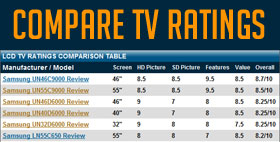LCD/LED TV Lifespan:
How Long do LCD TVs Last?
By: S. D. Davis
Much has been made of the longevity of LCD TVs, at least compared to plasma TVs. The conventional wisdom is that LCD/LED televisions last longer than their plasma TV counterparts, which was true. The problem is, a lot of people extrapolate from this that either (a) LCD/LED TVs last forever or (b) LCD/LED TVs suffer no picture "wear" over time. Neither of these conclusions is correct.
Flat-panel LCD TVs have a lifespan newly approaching 100,000 hours on average. The lifespan of an LCD TV is generally longer than that of similar-sized plasma televisions. Some manufacturers even claim that their LCDs can last upwards of 100,000 hours when used continuously under controlled conditions (e.g., in a room with "standard" lighting conditions and 77° temperatures throughout). Just how realistic such claims are is debatable. After all, whose living room has no windows and remains at a perfectly comfortable 77 degrees year-round?
In any case, the pictures on fluorescent backlit LCD TVs will show some "wear" because they are generated by powerful lamps, which, like any lighting appliance, will dim over time and with use. The picture you see will dim ever so slightly as the backlighting bulbs dim. One other consideration is that CFL fluorescent backlighting will change colors over time. This will change the white balance on your TV and cause color calibrations to be thrown off. See our article about How to Calibrate your TV here.
Therefore, the most important thing to consider when it comes to the lifespan of your LCD TV is the actual lifespan of the light source in your LCD. LCD TVs last as long as their lightsources do. So, the lightsource in your LCD TV is the critical component of your LCD display unit. Newly introduced LED backlit LCD TVs will have the best long term performance. LED backlighting is superior in that the white balance of the TV will not be affected by changing bulb color over time. It's a more consistent bulb technology and will also maintain its brightness longer.
The edge lit version of LED TVs will use far less energy while local dimming LED backlighting will be more accurate and present a better picture while using more power. We believe that local dimming LED backlighting will be slightly less stable from a life span standpoint.
To ensure the integrity of your lightsource for the duration of your LCD display's lifespan, you will definitely want to adjust the CONTRAST setting of your LCD TV. Too high of a CONTRAST level will prematurely age your lightsource because it will have to work harder to maintain such light intensities. Your best bet is to keep your CONTRAST set appropriately for the conditions under which your view your LCD display. Brighter ambient light levels require slightly higher CONTRAST levels, while lower ambient light levels demand less CONTRAST.
To learn more about LCD TVs and computer monitors, and what you need to know before you buy one, check out my article, "How To Buy An LCD TV In 8 Easy Steps".









